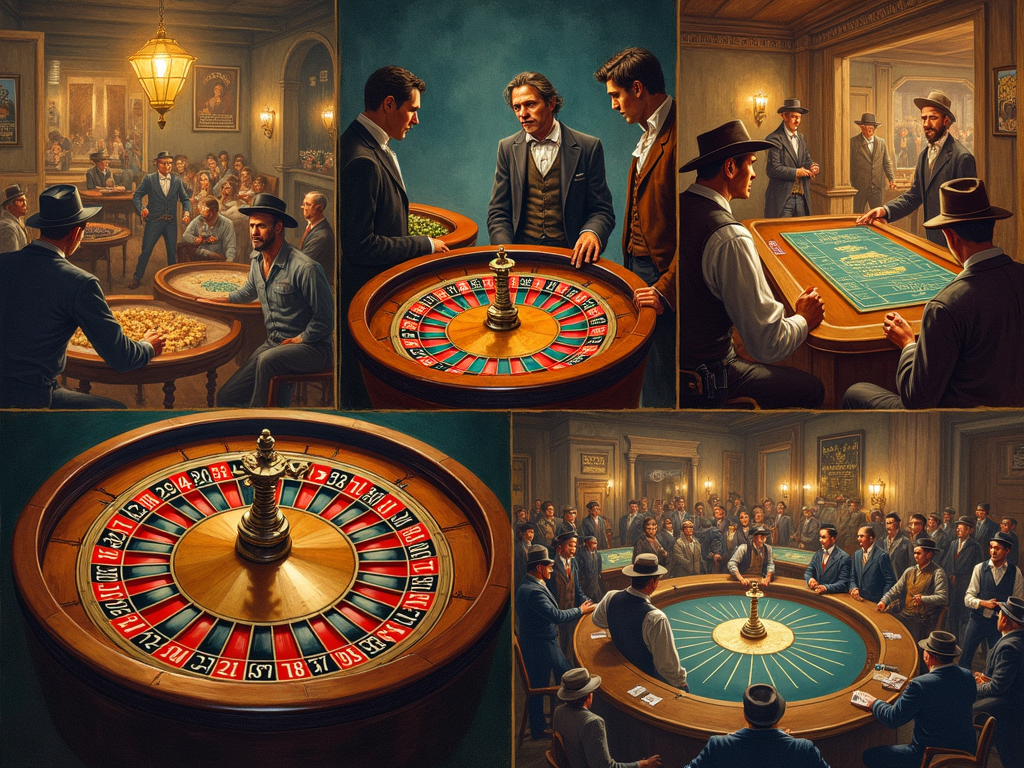The Fascinating Evolution of Roulette
Roulette emerged from Blaise Pascal’s failed scientific experiment and grew into a casino classic that captivates players worldwide. The game’s cultural shifts—from its French beginnings to American adaptations and digital formats—highlight its enduring appeal across generations.
Key Takeaways
- Blaise Pascal accidentally invented roulette in 1655 while attempting to create a perpetual motion machine.
- François and Louis Blanc transformed roulette by adding the single-zero wheel in Monaco, cutting the house edge from 5.26% to 2.70%.
- American roulette developed its own style by introducing a double-zero pocket, setting it apart from European versions.
- French roulette rules like ‘La Partage’ and ‘En Prison’ give players the best odds with a 1.35% house edge.
- Online platforms, live dealer games, and new variations have made roulette accessible to players everywhere in the digital era.
The Accidental Birth of a Casino Classic: Blaise Pascal’s Failed Experiment
Pascal’s Scientific Pursuit
The birth of roulette’s iconic spinning wheel emerged from an unexpected source: a failed scientific experiment. In 1655, French mathematician and physicist Blaise Pascal set out to create a perpetual motion machine – a device that would theoretically run forever without external energy. While his primary goal wasn’t achieved, this endeavor created something far more lasting.
Pascal’s mathematical genius shined through in his wheel design, incorporating elements that would later become crucial to modern roulette. His understanding of probability and physics led him to create the distinctive numbered pocket system, including the zero and double zero positions that give the house its edge.
Italian Influences and Evolution
Two Italian gambling games played a significant role in roulette’s development. Biribi and Hoca, popular in 17th-century Italy, used numbered boards and cups that shared similarities with Pascal’s wheel concept. These games provided the numbered betting format that would later merge with Pascal’s mechanical innovation.
The exact timeline of how Pascal’s wheel transformed from a scientific tool into a gambling device remains partially clouded in history. Here are the key elements that shaped its evolution:
- The addition of betting layouts inspired by Biribi and Hoca
- Integration of Pascal’s mathematical principles in pocket arrangement
- Development of the signature green zero pockets
- Adaptation of the wheel’s spinning mechanism for gambling purposes
This marriage of scientific precision and gaming entertainment created what would become a cornerstone of casino culture. Pascal’s failed experiment in perpetual motion ironically set in motion something entirely different – a game that’s kept spinning for over three centuries.
Monaco’s Game-Changing Innovation: The Single Zero Revolution
François and Louis Blanc transformed roulette forever with their groundbreaking single-zero innovation in 1843. These entrepreneurial brothers recognized that players needed better odds to stay engaged, leading them to create a modified wheel at their Bad Homburg casino.
The Strategic Evolution of Roulette Odds
The Blanc brothers’ modification was brilliantly simple – they removed one of the two zero pockets from the traditional wheel. This single change cut the house edge dramatically from 5.26% to 2.70%, making the game significantly more appealing to players. In an industry where small margins matter, this adjustment proved revolutionary for roulette’s long-term success and player engagement.
When Germany banned gambling in the 1860s, the brothers made a pivotal move to Monaco. Their relocation wasn’t just about finding a new home for their casino – it was about creating something extraordinary. The Monte Carlo Casino emerged as their masterpiece, quickly becoming the crown jewel of Monaco’s gambling scene.
I’ve identified the key factors that made the single-zero innovation so successful:
- Enhanced player confidence through better odds
- Increased playing time due to slower bankroll depletion
- Higher return rates that attracted wealthy patrons
- Perfect timing with Monaco’s need for economic growth
- Strategic marketing to European high society
The Blanc brothers’ business acumen didn’t stop at wheel design. They understood that combining better odds with luxury surroundings would attract elite clientele. This combination turned Monaco from a modest principality into Europe’s premier gambling destination.
Their innovation sparked a chain reaction – as players discovered the improved odds at Monte Carlo, other casinos faced pressure to adopt the single-zero format. The brothers had created a competitive advantage that redefined industry standards and players’ expectations.
The single-zero wheel became Monaco’s signature offering, cementing its reputation as the sophisticated alternative to other gambling destinations. This distinction helped establish Monte Carlo Casino as the standard-bearer for premium roulette experiences, a position it maintains today.
From New Orleans to the Wild West: American Roulette’s Journey
The vibrant city of New Orleans played a crucial role in introducing roulette to America in the early 1800s. French immigrants carried their beloved game across the Atlantic, setting up gambling houses that would forever change the American gaming landscape.
The American Innovation
The American version of roulette quickly evolved into its own unique style, featuring a distinctive wheel with numbers 1-28, a single zero, a double zero, and an American Eagle symbol. This extra pocket – the American Eagle – pushed the house edge to approximately 9.68%, making it significantly higher than its European counterpart.
As fortune seekers headed west during the Gold Rush, gambling establishments popped up along the Mississippi River, carrying roulette’s influence deep into America’s heartland. These early American gambling houses created a unique gaming culture that shaped modern casino practices.
Here’s how the American roulette wheel transformed during its westward expansion:
- The original American Eagle symbol served as an extra house pocket
- Riverboat casinos standardized gaming rules along the Mississippi
- Local variations emerged in different territories and states
- The wheel eventually settled into the modern double-zero format
The game’s popularity soared in frontier towns, where makeshift casinos served prospectors and settlers alike. The high house edge of early American roulette didn’t deter players – instead, it added to the game’s reputation for high-stakes excitement. By the late 1800s, the modern double-zero format had become standard across American casinos, dropping the Eagle symbol but maintaining a distinctive identity from its European ancestor.
Professional gamblers and casino operators streamlined the game, establishing consistent rules that would later influence modern gaming regulations. The standardization helped roulette maintain its position as a casino staple, even as other gambling games came and went.

Modern Variations and Better Odds: European vs American Roulette
Understanding the Key Differences
I’ve found that the most significant difference between European and American roulette lies in their wheel designs. European roulette features a single zero (0), while American roulette includes both a single zero (0) and double zero (00). This seemingly small variation creates a substantial impact on your chances of winning. The European version maintains a 2.70% house edge, making it a more favorable choice compared to the American variant’s steeper 5.26% house edge.
The number sequences on each wheel also differ noticeably. While both versions feature numbers 1-36 in red and black, their arrangements create distinct betting patterns. The American wheel places opposite numbers across from each other, while the European wheel follows a more random sequence that adds excitement to each spin.
French Rules and Enhanced Player Odds
French roulette takes the European version a step further by introducing two player-friendly rules: ‘La Partage’ and ‘En Prison’. These rules apply to even-money bets when the ball lands on zero, cutting the house edge to an impressive 1.35%. Here’s how each rule works:
- La Partage: You receive half your stake back on even-money bets if the ball lands on zero
- En Prison: Your even-money bet remains ‘imprisoned’ for the next spin, giving you another chance to win
- Both rules only apply to outside bets like red/black, odd/even, and high/low
Today’s casinos worldwide offer both American and European variations, though I’ve noticed European roulette gaining popularity in North American establishments due to its better odds. The choice between versions often depends on the casino’s location and target market, but savvy players typically gravitate toward European roulette for its more favorable odds.
Digital Revolution: Roulette in the Internet Age
The Rise of Online Roulette Gaming
The mid-1990s brought a dramatic shift in how players could access and enjoy roulette with the emergence of online casinos. Digital roulette games, powered by Random Number Generator (RNG) technology, created a new way to experience this classic casino game from home. I’ve seen firsthand how these early digital versions laid the groundwork for what would become a massive transformation in gambling entertainment.
Leading software developers have shaped the digital roulette landscape significantly. Microgaming pioneered some of the first online roulette games, while Playtech, Evolution Gaming, and NetEnt have continued to push boundaries with cutting-edge features and realistic gameplay. Their innovations have made playing roulette online an immersive and authentic experience.
Innovation and Accessibility
Live Dealer roulette represents one of the most significant advances in online gaming. By combining real dealers, physical wheels, and digital accessibility, these games create an authentic casino atmosphere right on your screen. The real-time interaction with dealers and other players adds a social element that was missing from earlier digital versions.
The digital age has introduced exciting new variations of the classic game:
- Mini Roulette offers a simplified version with fewer numbers
- Multi-Wheel Roulette lets players bet on up to eight wheels simultaneously
- Speed Roulette cuts game time to increase action and excitement
- Lightning Roulette adds random multipliers for enhanced winning potential
Mobile gaming technology has transformed how players access roulette games. The ability to play on smartphones and tablets means you can enjoy a quick game wherever you are. This increased accessibility has brought roulette to a whole new generation of players, making it more popular than ever before.
The integration of secure payment systems and fair gaming certifications has built trust in online roulette platforms. Regular audits and transparency measures ensure that digital versions maintain the same randomness and fairness as their physical counterparts.

Sources:
Encyclopedia Britannica, Article: Roulette
Schwartz, David G., Book: Roll the Bones: The History of Gambling
Monte Carlo SBM (Société des Bains de Mer), Corporate History Information
Casino.org, Article: The History Of Roulette: From Humble Beginnings To Worldwide Fame
Bovada Casino Blog, Article: The History of Roulette




